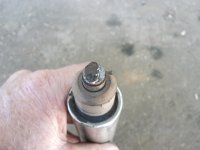getting a lot of conflicting opinions........just throwing momey at it without more diagnostics isn't what o would be doing.
First thing i would do is examine the front wheel/tyre for bent rim, loose spokes, tyre not beaded into the rim properly and a bulge in the tyre wall.
On the center stand and a jack under the front engine mount till the front wheel is off the ground. Spin the front wheel and hold a stick, pencil, piece of anything really, bracing your hand and point the end at the edge of the inside of the rim and spin the wheel. This will show if the rim isn't true, either sideways or up and down. If that is ok spin the wheel again, or just do it slow, and check the sidewall, Or anywhere on the tyre, for a bulge. They can be hard to see sometimes so again use a marker to check the tyre for round
If that is ok, go around and hit the spokes and listen to the sound, A good spoke will ring, a dud spoke sounds dull/flat...............test the spokes even if you find a problem somewhere else just as a maintenance check
While the front is off the ground check the steering head bearings for the right tension. Hold the handle bars straight and then let go and let the front wheel fall to the side. if it falls fast and crashes against the stop quite hard means the front end is loose, If it stays facing the front without falling then the front is to tight, or is a severe case the original bearings have been worn and the PO has over tightened it to take up the slack................this could be a cause of a wobble or hunting, (a term used to describe when the bike/car wants to weave). The front should fall to the side in an orderly calm manor.............If the front is adjusted per the manual, not to tight or to loose, even with the original bearings in it you can determine if the bearings have Brinnelled as you will feel it by turning the front forks slowly side to side. There will be some resistance, ( i agree with Jetmarty, the brinnelling should be as the forks face the front as that is where they are sitting 90% of the time).
Again while the front is up and if all of the above has been checked check the front Wheel bearing by pushing and pulling and twisting on the front wheel, Doesn't have to be hard just use steady force and listen for sounds or any vibration through the wheel.
The rear wheel should be checked as well, Tyre, spokes, tyre beading, and the bearings.
If everything works out ok, do check the shocks on the bike. Take them off and test the rebound on them.
As an aside
I had a set of shocks that looked ok and while i had the ba ck wheel off i was just sitting there and without thinking of a reason why i grabbed the shock and wiggled t back and forward. It exploded on my hand. The shaft snaped off at the top mount and the spring and cap flew off. Looking at the shaft it had an old crack, (metal fatigue), that finally gave way when i gently wiggled it side to side.................. As you can see, where the fresh break is






